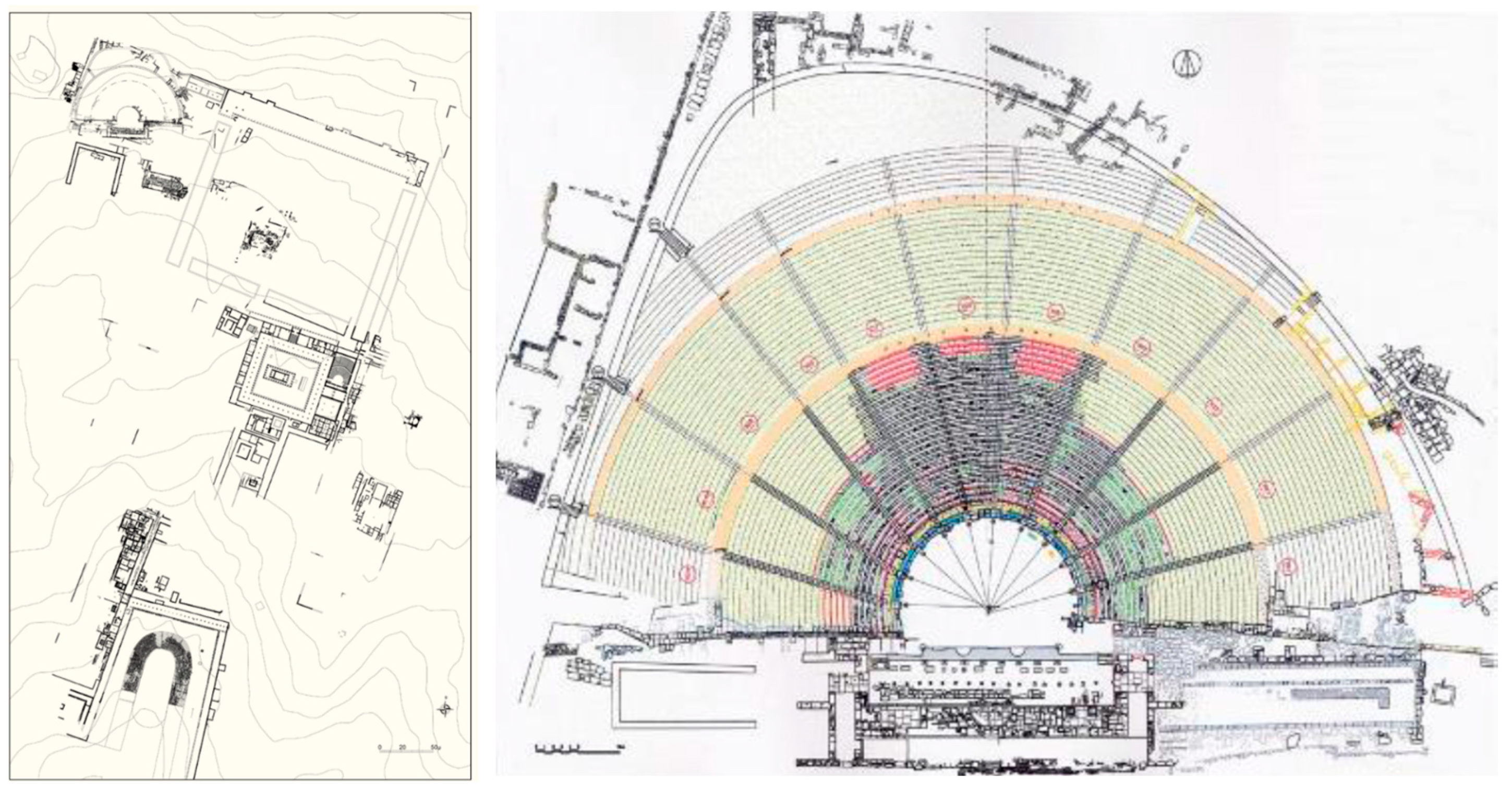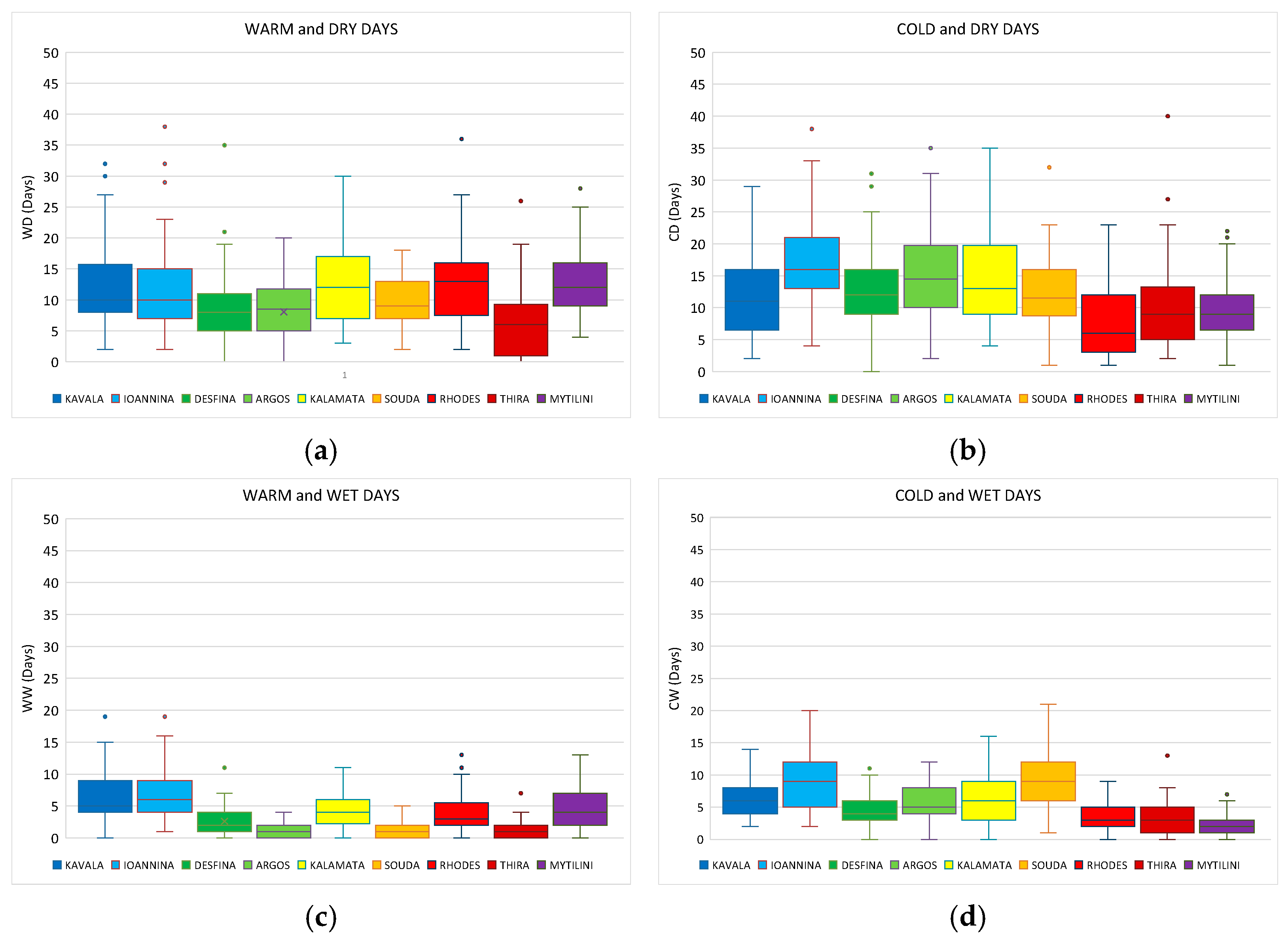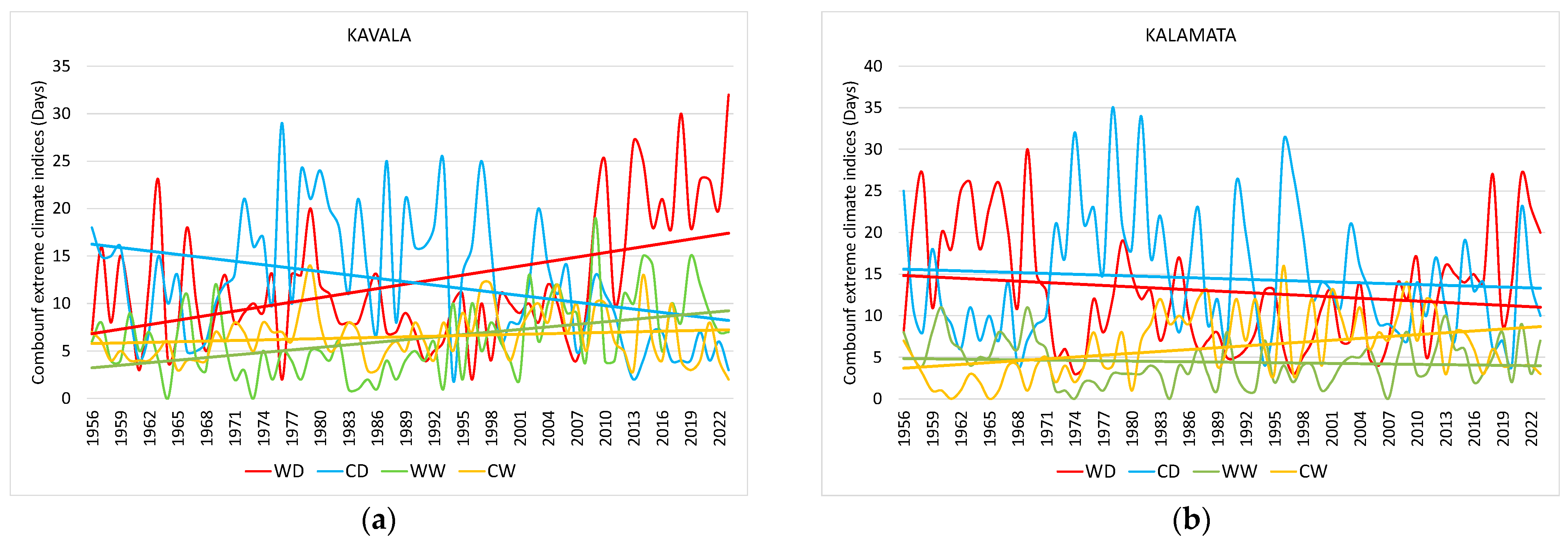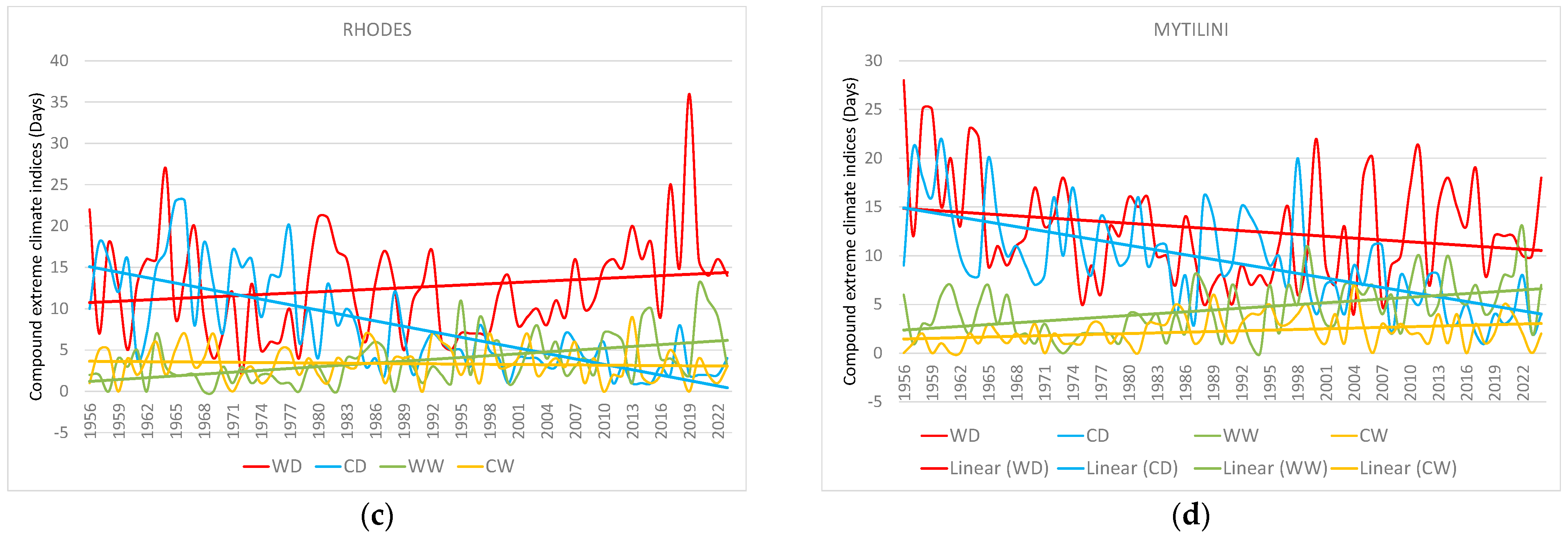1. Introduction
Climate change and its continuous progress threaten to influence all aspects of daily life, with a particular threat to cultural and natural heritage. The intensity of its manifestations (e.g., extreme weather events, their frequency and intensity) draws society’s attention to long-term issues of conservation and protection from its impacts on cultural and natural heritage, or more generally on society and its activities [
1]. The impacts of climate change are multiple and appear at various levels of daily life on the planet, particularly on the natural environment and the global economy, which in turn will affect the local economy and human health [
2].
Climate change is increasingly recognized as a threat to World Heritage Sites (WH- sites). Cultural heritage is often considered merely a reminder of the glory of the past, but it also concerns the continuity of history in the present, the heritage values which form today’s societies, and global diversity, and therefore it must be protected from various threats, such as climate change [
3].
The importance of sustainability of cultural heritage in the modern era of humanity is vital, during times of challenges and transitions of society. In this context of progress, modern society is multicultural, with an increased acceptance of diversity [
4]. Also, climate change and the need for sustainability are a vital part of global concern in recent decades with political initiatives and social actions related to strategies for the protection and management of culture and natural heritage [
5]. As climate change is an ongoing reality, there are already impacts on the sectors of health, society, and the natural environment, with increasingly frequent occurrence of risk and hazards for the monuments such as drought, floods, and fires [
6].
Heritage assets are in jeopardy due to the effects of climate change and they are threatened with structural decay and degradation of the cultural significance, which includes the history of civilization, constitutes the identity of the place, presents cultural and natural aspects as well as tangible and intangible facets, carries heritage values, and is characterized by authenticity and integrity. There is an urgent need to protect and transmit the culture and the heritage values to the next generations, as they reflect and incorporate the history of humanity and the progress of civilizations [
7].
For further evaluation of the impacts on heritage, this paper underlines the simultaneous occurrence of climate extremes, which results in conditions of heritage deterioration on the ancient Greek theatres, which constitute an open-air cultural structure.
2. Materials and Methods
The ancient Greek theatre, as a special example of cultural heritage, has a familiar form of the whole and its parts (stage, orchestra, and cavea), an identity that is inextricably linked to the specific architectural form, the legible type of the theatre, and its relationship with the natural landscape (
Figure 1). Ancient Greek theatres are integrated into the landscape, emphasising the direct relationship of culture with the surrounding space so as to constitute a composition harmonized with the place. The risks of the effects of climate change undermine the sustainability of heritage and of theatres. Thus, there is indispensable need for protection and adequate heritage management.
The ancient Greek theatres studied as case studies of the present paper along with the nearest meteorological stations from the Hellenic National Meteorological Service (in parentheses) [
9] concern the cultural landscape of Filippoi (Kavala), Dodoni (Ioannina), Delphi (Desfina), Epidavros (Argos), Messini (Kalamata), Aptera (Souda), Lindos (Rhodes), Thira (Thira), and Mytilini (Mytilini). As far as the relation of compound climate extremes with the damage, the risks, and the ongoing degradation of the heritage (materials, structures, landscape) is concerned, historical meteorological data were acquired from the Hellenic National Meteorological Service (HNMS) to assess the frequency and impacts of warm–wet, warm–dry, cold–wet, and cold–dry climate extremes on these structures. The compound climate extreme indices are defined by the exceedances of the joint modes of air temperature and precipitation using the 25th and 75th percentile levels [
10]. The calculation of the climate extremes was performed using the appropriate code in Python 3.13.7. A multi-decadal statistical analysis was performed to quantify the occurrence, variability, and magnitude of four extreme compound indices—across the nine meteorological stations in Greece. Data records range from 44 to 69 years depending on the station, with most exceeding six decades. For each category, descriptive statistics (median, interquartile range [IQR], minimum, maximum, and range) by means of Box and Whisker plots were calculated, while the trends were analysed using the Mann–Kendall test, which is a non-parametric statistical test.
3. Results and Discussion
The Box and Whisker plots for the compound climate extremes (
Figure 2) across Greece highlight marked regional differences in both the magnitude and variability of these indices.
In Warm Days (WD), the highest median frequency is observed at Rhodes (13 days/year), followed by Kalamata and Mytilini (12 days/year each). The lowest median is recorded at Thira (6 days/year). Variability is greatest at Kalamata (IQR = 10.0), while the widest range occurs at Thira (94 days; min 0, max 94; not shown in the graph), far exceeding the next highest values (Ioannina = 36, Desfina = 35). Zero-event years are recorded at Argos, Desfina, and Thira.
In Cold and Dry Days (CD), Ioannina ranks highest (median 16 days/year), with Argos (14.5), Kalamata (13.0), and Desfina (12.0) also showing elevated values. The lowest median is found at Rhodes (6 days/year). Kalamata again shows the largest IQR (10.25), while Thira exhibits the widest range (38 days; min 2, max 40). Years with no CD events are observed at Souda, Mytilini, and Rhodes.
For Warm and Wet Days (WW), the highest median occurs at Ioannina (6 days/year), followed by Kavala (5). Kalamata and Mytilini each record 4 days/year, while the lowest medians (1) are found at Argos, Souda, and Thira. The largest IQRs (5.0 days) are recorded at Ioannina, Kavala, and Mytilini, and the widest range belongs to Kavala (19 days; min 0, max 19), followed closely by Ioannina (18). Multiple stations (Argos, Souda, Thira) have years without any WW days.
In Cold and Wet Days (CW), Ioannina and Souda share the highest median (9 days/year), followed by Kavala and Kalamata (6). Mytilini records the lowest median (2). The largest IQR is found at Ioannina (7.0), while Souda has the widest range (20 days; min 1, max 21). Years without CW events occur at Thira, Rhodes, and Mytilini.
Analysis of the extremes highlights the potential for prolonged events: Thira records the most in WD (94 days/year) and CD (40 days/year), Kavala and Ioannina hold the highest in WW (19 days/year), and Souda leads in CW (21 days/year). These values indicate that under exceptional conditions, extreme categories can persist for extended periods well beyond their medians. The presence of zero-event years for several stations in multiple categories underscores the episodic nature of these extremes, especially in maritime climates. Overall, the results reveal distinct station-specific climatic profiles. Ioannina consistently ranks high in CD, WW, and CW medians, reflecting frequent occurrence of both cold-related and warm–wet extremes, alongside high interannual variability. Kalamata shows high medians for WD and CD and the greatest variability in both, making it a variability hotspot. Rhodes is warm-dominated, leading in WD but lowest in CD. Thira has the lowest WD median yet exhibits the most extreme recorded maxima for WD and CD, producing the largest ranges. Souda ties with Ioannina for the highest CW median and shows the widest CW range, while Kavala stands out for WW extremes.
Table 1 depicting the trends (in days per year) of compound extreme climate indices—namely Warm/Dry (WD), Cold/Dry (CD), Warm/Wet (WW), and Cold/Wet (CW)—across nine meteorological stations in Greece reveals important spatial and temporal patterns associated with climate variability and change. Statistically significant trends at the 95% confidence level are marked with an asterisk and provide insights into how different regions in Greece are responding to shifts in temperature and precipitation extremes. Timeseries of compound extreme climate indices for representative locations are depicted on
Figure 3.
Warm–dry (WD) extremes present both positive and negative trends across the network, with the most pronounced and statistically significant increase recorded in Thira (0.65 *), indicating a strong warming–drying tendency that could intensify drought risk. Moderate but significant WD increases are also observed in Kavala (0.16 *) and Ioannina (0.05 *). In contrast, cold–dry (CD) extremes exhibit predominantly negative trends, with the largest and statistically significant decreases found in Argos (−0.23 *), Rhodes (−0.22 *), Mytilini (−0.16*), Desfina (−0.14 *), Kavala (−0.12 *), and Souda (−0.11 *), reflecting fewer cold–dry events and pointing to an overall warming signal. Warm–wet (WW) extremes generally show small but significant positive trends in several locations, including Kavala, Ioannina, Rhodes, Thira, and Mytilini, suggesting a mild increase in precipitation during warm conditions. Cold–wet (CW) extremes display mostly weak and inconsistent changes, with only a few stations (Ioannina, Kalamata, Mytilini) showing small but significant positive trends.
Spatially, southern and island stations—particularly Thira and Rhodes—emerge as prominent hotspots for increases in both WD and WW extremes. In these areas, the combination of rising sea surface temperatures, altered wind patterns, and prolonged summer dry spells may be intensifying both heat and moisture extremes, leading to more frequent hot, dry periods as well as heavy rainfall events under warm conditions. Interestingly, Kavala, located in northern Greece and influenced by both continental and maritime climatic regimes, also exhibits a significant WD increase. This finding indicates that warming–drying tendencies are not confined to the traditionally more vulnerable southern or island regions but can also manifest in northern areas—likely linked to broader regional circulation changes and shifts in seasonal precipitation patterns.
The widespread and statistically significant decline in CD extremes across multiple stations reflects a consistent trend towards milder winters and a reduction in cold–dry spells. This pattern is consistent with broader Mediterranean climate change projections, which anticipate warmer winters with reduced frost risk, albeit with potential knock-on effects for ecosystems and agricultural practices that depend on winter chilling.
Regarding CW extremes, the spatial pattern is more fragmented. Increases are mainly observed in Ioannina (northwest Greece), Kalamata (southern Peloponnese), and Mytilini (North Aegean Island), suggesting that cold–wet events are not following a clear north–south gradient. Instead, their distribution appears to be influenced by local climatic factors such as orographic rainfall enhancement, proximity to moisture sources, and seasonal storm track variability. The localized nature of these increases indicates that CW extremes may be more sensitive to regional weather systems than to broader climatic warming trends.
4. Conclusions
This study demonstrates that compound climate extremes—warm–dry, cold–dry, warm–wet, and cold–wet events—are increasingly influencing the climatic exposure and structural vulnerability of open-air ancient Greek theatres. Multi-decadal analysis reveals distinct spatial patterns and statistically significant trends, reflecting both regional variability and overarching climate change signals.
Warm–dry extremes show marked increases in Thira, Kavala, and Ioannina, indicating heightened drought and heat stress risks for heritage materials. In contrast, cold–dry extremes have declined across most stations, consistent with milder Mediterranean winters and reduced frost incidence. Warm–wet extremes exhibit small yet significant increases in several regions, raising the likelihood of intense rainfall under warm conditions—favouring both physical weathering and the biological colonisation of stone surfaces. Cold–wet extremes show no uniform trend, with increases confined to Ioannina, Kalamata, and Mytilini, driven by localized climatic factors.
These findings confirm that heritage assets face compound and evolving climatic pressures, demanding both immediate maintenance interventions and long-term conservation strategies. Effective heritage management should integrate high-resolution meteorological data into proactive monitoring systems, apply locally tailored mitigation–adaptation measures, and embed these within broader cultural heritage policies.











